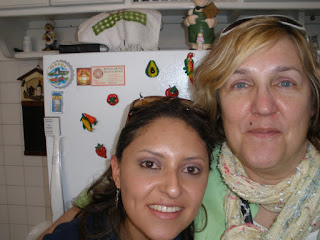We didn’t volunteer in Ecuador, so no color code is necessary. You’ll notice I went ahead and included the location names right next to the map. Is this helpful or not?
 32 – Tulcán – early morning of 2/22 – An all-night bus from Cali, Colombia took us to the border earlier than anticipated. We waited for the sun to rise to make for a safer border crossing into this small Ecuadorian town.
32 – Tulcán – early morning of 2/22 – An all-night bus from Cali, Colombia took us to the border earlier than anticipated. We waited for the sun to rise to make for a safer border crossing into this small Ecuadorian town. 33 – Quito – 2/22 to 3/05 – We stayed with Eleana Figueroa (Ele), Joe’s family’s former foreign exchange student, her brother and sister in Quito. They have a nice apartment a little ways north of the city center. And they were INCREDIBLE hosts! Here Joe’s mom came for a week, also using their home as a central base for other travels. We were all impressed by the unique, beautiful churches and plazas, along with happening, hip neighborhoods Quito has to offer. Though polluted, Quito was a good place to be.
34 – Otavalo – 2/26 to 2/27 – We, including the mother, fell victim to Otavalo’s main tourist attraction—it’s lively, touristy market. Everything we owned ended up spewing forth soft alpaca accessories, minus our wallets, which weren’t spewing forth much at all. Juleen proved the master market negotiator of the three. A hostel situated amid the rolling green and rocky volcanoes, plus good pizza made the short trip even more pleasant.
It seems this country has a lot to offer. The fact that it’s smaller makes its distinct climates and locations much more accessible, which is a big plus compared to relative giants Colombia and Peru. It was also significantly cheaper than Colombia—another bonus. Though we didn’t volunteer, spending time with Ele, her family and Joe’s mom made the time substantive enough that it didn’t seem like we were lacking in the I-need-to-be-productive department; this has haunted Joe especially during previous extended traveling phases of the trip. In the end, we highly recommend the parts of Ecuador we saw (particularly Cuenca, Julie and Harold!), and we’re anxious to see more.








